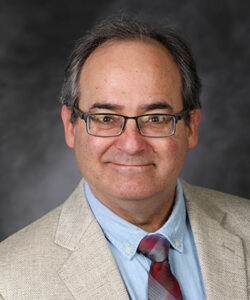Historical resilience amid historical trauma
On Indigenous Peoples Day, a film and panel discussion at UND bring those concepts to life

“Power to the people,” activists called for in the 1960s, speaking out at the time against the seeming domination of society by a ruling class.
Now it’s 50 years later, and if the phrase needs an update, perhaps it’s one suggested by the film “Oyate” — a documentary that shows the “power of the people” to spread awareness of issues and injustices and spark action around the globe.
“Oyate” documents the history and context of the 2016 Dakota Access Pipeline protests and #NoDAPL movement. In honor of Indigenous Peoples Day and sponsored by Student Diversity & Inclusion and Indians into Medicine at UND, the film was shown in the Memorial Union’s Social Staircase area on Oct. 10 and followed by a panel discussion.
The word “oyate” is a traditional Dakota term meaning “people” or “nation.” Over and over again, the film “Oyate” showed how the pipeline resistance demonstrators, though they were gathered on a remote North Dakota prairie that was far from any media center, nevertheless drew the attention of not only state leaders but also the American people, the U.S government — up to and including two presidents of the United States — and the United Nations.
“I think that’s the biggest thing the whole situation showed: the power of unity,” said Stuart James, a Spirit Lake-based hip-hop artist who spoke as a panelist after the screening.
“In one of my songs, I said as the first line, ‘Imagine what would happen if our people came together.’ And the #NoDAPL movement was an example of that. …
“It showed how, when our leaders put aside their egos and when we all speak with one voice, one prayer, one mind and one consciousness, we literally can spark a change that spreads across the entire world. That’s what happens when our people come together,” as James had suggested in his song.
Vicki Alberts, a UND law student, member of the Native American Law Students Association and also a panelist after the screening, agreed. The pipeline issue arose “at a time when Indigenous consciousness was rising,” Alberts said.
“And it inspired in a lot of us a kind of a spirit; it ignited a fire.” That spirit brought together tribes from across the region and even around the continent, despite rivalries and other quarrels that on other occasions had prevented cooperation.
The unified message: “We cannot allow these activities (such as the pipeline construction) to take place in our tribal communities,” Alberts said. Enough is enough, and people need look only at such events as the construction of the Garrison Dam — a 1950s-era project that submerged whole communities of the Three Affiliated Tribes, forced the relocation of 1,700 residents and left the reservation without its most fertile lands — to see that the tribes have suffered enough.

Bringing about change
Alberts paused. “I don’t like the term ‘historical trauma,’” she said.
“I like the term ‘historical resilience,’ because I believe we are a very resilient people. … Our people have been through so much; we weren’t even citizens of this nation until 1924.” But through it all, Native people and their culture survived, to the point where the nation and the world now are paying much closer attention to Indigenous voices.
“That’s the reason I’m in law school: because I want to see change, and I want to help bring about change,” Alberts said. And she’s in great company, considering the example set by contemporary leaders such as Deb Haaland, the then-congresswoman who appears in the film and now is the first Native American to serve as secretary of the Interior.
Speaking of law school, Jim Grijalva, a professor at the UND School of Law, also served on the panel. “I’m a lawyer, and I’ve been working in environmental law in Indian country for 30-some years,” he said.
“So, one of the things I’d say about the film is that extractive industries have a history of taking valuable resources from Indigenous communities and territories, and turning those resources into value that primarily benefits the majority communities.”
What set the Dakota Access Pipeline project apart was not necessarily its destructiveness, “but the fact that it happened at a time when Indigenous consciousness and environmental support were significant,” Grijalva said.
“Plus, not only are we trying to deal with climate change, but also we’re realizing that environmental justice is important. That means we can’t just leave the bad stuff and the dangerous stuff in the communities of Indigenous people, of low-income people and minority people, especially when the benefits run most of the time to the majority communities.”
Couple the above with the fact that at the protest’s height, more than 10,000 people had gathered at the protest camp, and you’ve got a movement that captured the attention and support from around the world, he said.
An annual tradition
This year marked the fourth during which UND has celebrated Indigenous Peoples Day, and the enthusiasm around the date has helped it quickly become a UND tradition, said Stacey Borboa-Peterson, director for Student Diversity & Inclusion, in an earlier story in UND Today.
Borboa-Peterson’s team collaborated with Dr. Daniel Henry from the Indians into Medicine program, as well as Sonya Anderson, a clinical instructor in the Department of Nursing, to develop this year’s activities.
Events such as Indigenous Peoples Day provide an awareness of culture and traditions of Indigenous people, Borboa-Peterson said, and help create and foster a sense of pride and belonging for the Indigenous community on and around campus.
“There is so much enthusiasm from people to come together and celebrate Indigenous Peoples Day,” she remarked. “We hope that participants can sense that and be encouraged to engage and learn throughout the day.”
Dr. Henry of the INMED program also moderated the post-film panel and posed questions to the three panelists. Part of what gives the #NoDAPL movement its power is the public’s growing awareness of Native people’s respect for the environment, he suggested.
“We’re taught that we recognize not only our paths but also the paths of the three generations that preceded us and the three generations that will follow,” he said.
“So when we talk about seven generations, that’s very real. … Everything we do is for our grandchildren, our great-grandchildren and our great-great-grandchildren,” and also is done in consideration of tribal ancestors and traditions.
That’s a pretty good approach, as modern science and environmental awareness have confirmed, Henry suggested.
“You know, it was prophesized that Indigenous people are going to be the ones who teach that to the rest of the world, who show how to live together and in harmony with Mother Earth,” he said.
“Hopefully, that’s what’s going to happen in the future; and that’s what this day is about.”



